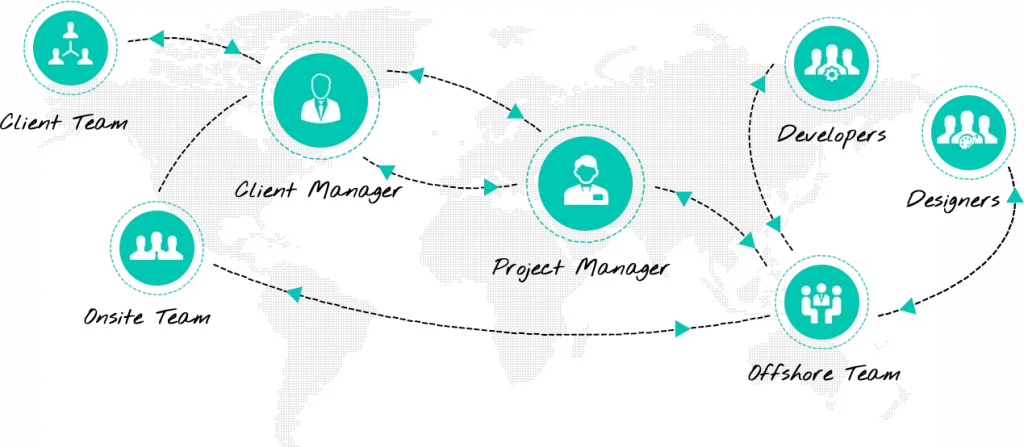Agile software development outsourcing has become a cornerstone of modern software engineering, promoting flexibility, continuous improvement, and customer satisfaction. In an increasingly globalized economy, outsourcing Agile development to offshore development centers has emerged as a strategic approach for businesses seeking efficiency and innovation. This article explores the benefits of Agile software development outsourcing and outlines best practices to ensure successful implementation.
Benefits of Agile Software Development Outsourcing
- 1. Flexibility and Adaptability Agile methodologies prioritize adaptability, allowing development teams to respond quickly to changing requirements and market conditions. Outsourcing Agile development enables businesses to leverage the flexibility of remote teams, ensuring projects can pivot as needed without significant delays or cost overruns.
- 2. Faster Time-to-Market Agile’s iterative approach accelerates the development process by breaking projects into manageable sprints. This results in faster delivery of functional software, giving businesses a competitive edge. Outsourcing to skilled Agile teams can further expedite this process, as they often have the experience and resources to hit the ground running.
- 3. Cost-Effectiveness Outsourcing Agile development can be more cost-effective than maintaining an in-house team, particularly for short-term or specialized projects. Offshore development centers offer competitive pricing structures, allowing businesses to optimize their budgets while accessing high-quality software development services.
- 4. Access to Global Talent Outsourcing opens the door to a global talent pool, enabling businesses to find the best developers regardless of geographical constraints. Offshore development centers often employ highly skilled professionals with expertise in various technologies and methodologies, enhancing the overall quality and innovation of the project.
- 5. Enhanced Collaboration and Communication Agile emphasizes regular communication and collaboration between stakeholders and development teams. Modern communication tools and project management software make it easier than ever to maintain effective collaboration with offshore teams, ensuring everyone stays aligned and informed.

Role of Offshore Development Centers in Agile Outsourcing
Offshore development centers (ODCs) are dedicated facilities set up by businesses in foreign countries to leverage local talent and resources. These centers are integral to Agile outsourcing, providing a stable and scalable environment for software development.

ODCs support Agile methodologies by offering:
- – Dedicated Teams: Offshore centers often provide dedicated teams that work exclusively on a client’s project, ensuring continuity and deep project knowledge.
- – Infrastructure: ODCs are equipped with the necessary infrastructure to support Agile practices, including high-speed internet, advanced communication tools, and secure data management systems.
- – Cultural Alignment: Many ODCs focus on fostering cultural alignment with their clients, promoting a shared understanding of Agile values and practices.
Best Practices for Agile Software Development Outsourcing
1. Selecting the Right Outsourcing Partner
- – Choose partners with a proven track record in Agile development and a deep understanding of your industry.
- – Conduct thorough due diligence, including reviews, references, and case studies.
2. Establishing Clear Communication Channels
- – Use collaborative tools like Slack, Jira, and Zoom to facilitate regular communication and ensure transparency.
- – Schedule regular meetings and updates to keep all stakeholders aligned.
3. Setting Realistic Goals and Expectations
- – Define clear objectives, timelines, and deliverables from the outset.
- – Maintain a flexible approach to accommodate changes and improvements.
4. Continuous Integration and Iterative Testing
- – Implement continuous integration (CI) and continuous delivery (CD) practices to ensure code quality and rapid feedback.
- – Conduct regular testing and reviews at the end of each sprint.
5. Encouraging a Culture of Collaboration and Trust
- – Foster a collaborative environment where team members feel valued and motivated.
- – Build trust through transparent communication and shared goals.

Challenges and Solutions
Common challenges in Agile outsourcing include:
- – Cultural and Language Barriers: Overcome these by investing in cultural training and using clear, concise communication.
- – Time Zone Differences: Mitigate time zone challenges by establishing overlapping working hours and using asynchronous communication tools.
- – Quality Control: Ensure quality through regular code reviews, automated testing, and continuous feedback loops.
Conclusion
Agile software development outsourcing offers numerous benefits, including flexibility, faster time-to-market, cost-effectiveness, and access to global talent. By leveraging offshore development centers and adhering to best practices, businesses can successfully implement Agile methodologies and drive their digital transformation efforts. Embracing Agile software development outsourcing can lead to enhanced innovation, efficiency, and business success.













